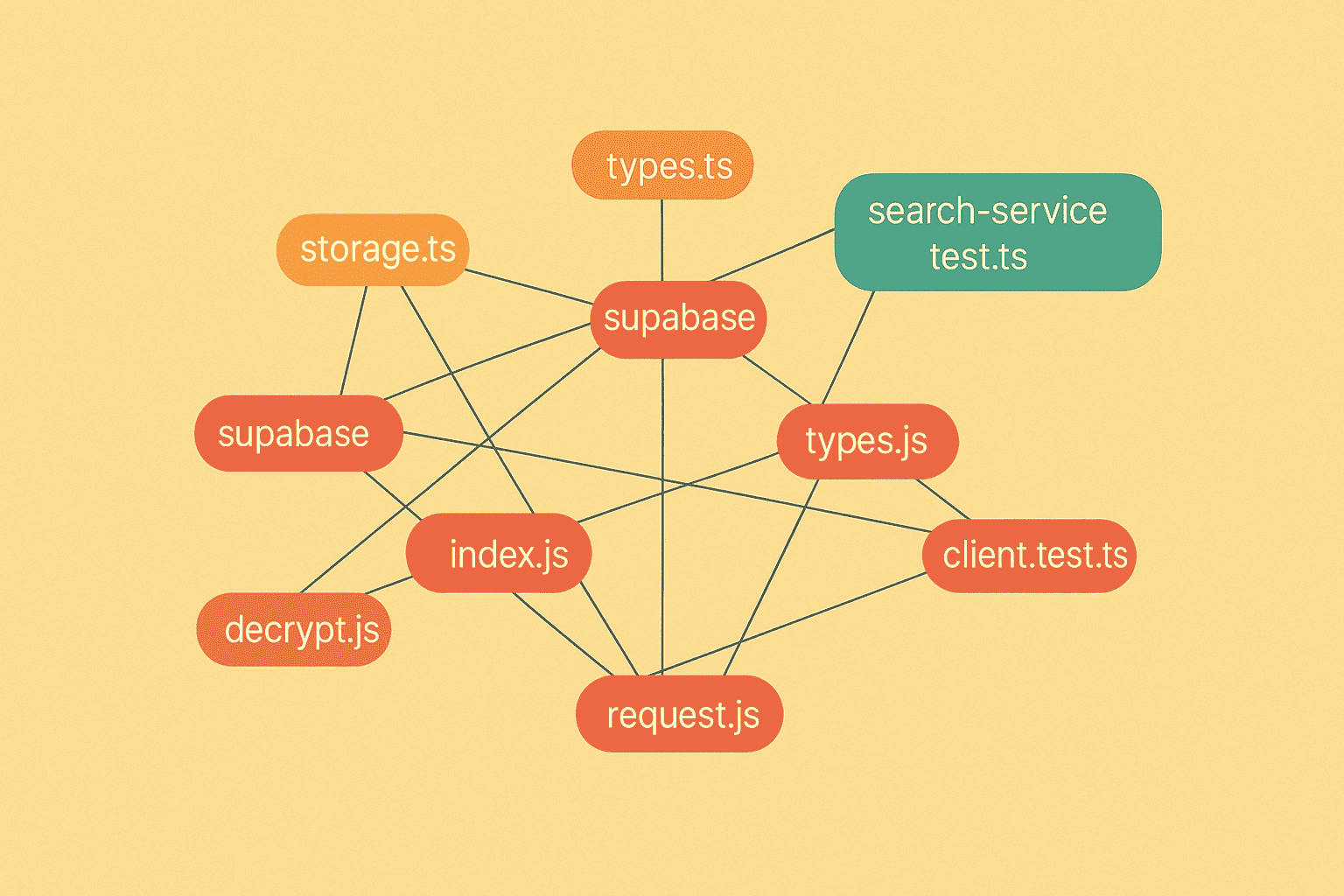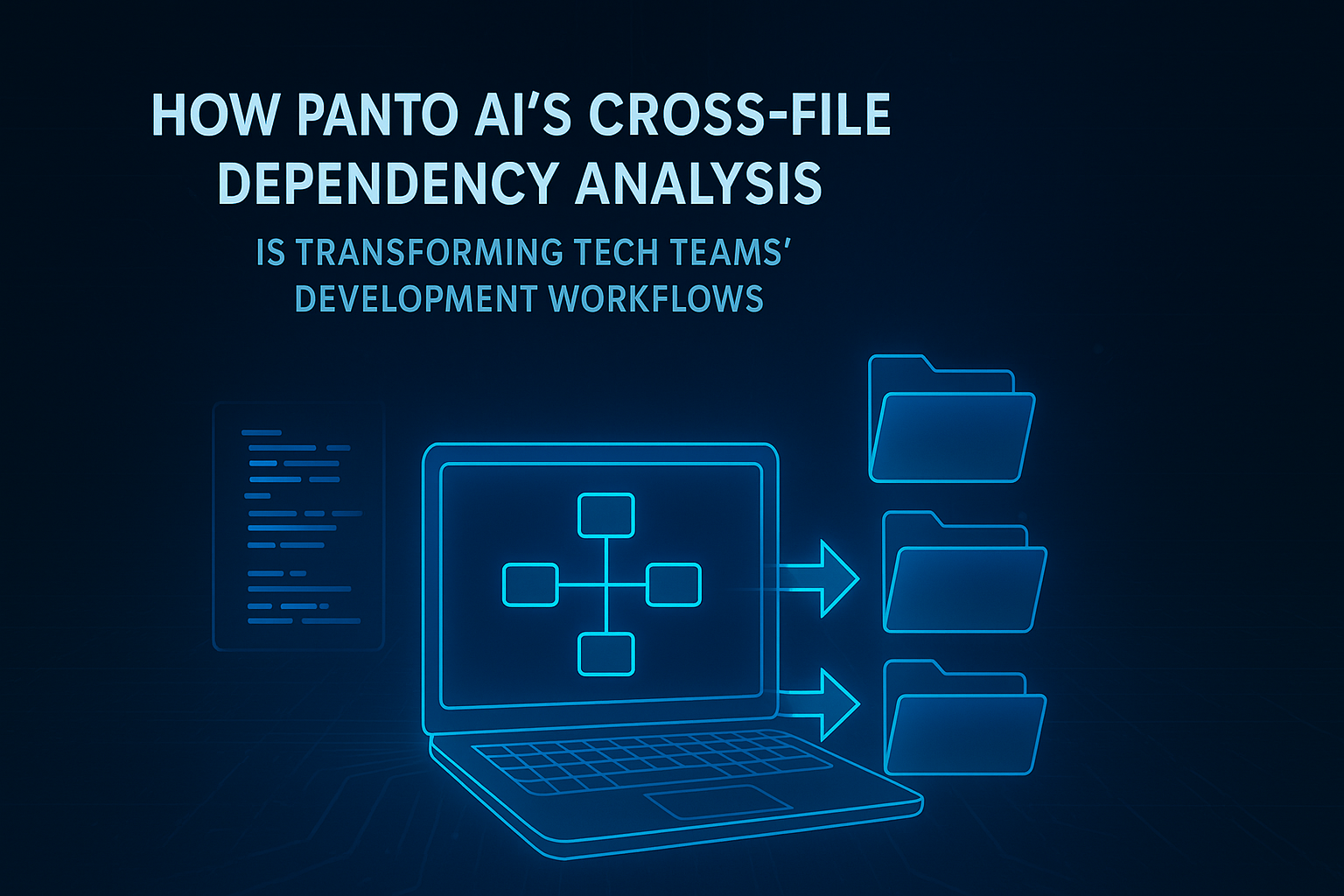In the rapidly evolving landscape of software development, where applications grow increasingly complex and interdependent, tech teams face a critical challenge: ensuring that code changes don’t inadvertently break functionality elsewhere in the codebase. Traditional code review tools, while valuable, often operate within the confines of individual files or commits, leaving developers blind to the broader implications of their modifications. This limitation has led to countless production incidents, delayed releases, and frustrated development teams struggling to maintain code integrity across sprawling codebases.
Enter Panto AI, the groundbreaking code review and security AI agent that’s addressing this fundamental gap with an industry-first innovation: Cross-File Dependency Analysis. This revolutionary feature represents a paradigm shift in how we approach code review, moving beyond isolated diff analysis to provide comprehensive visibility into the interconnected web of dependencies that define modern software systems.
The Hidden Complexity Crisis in Modern Development

Today’s software applications are marvels of interconnected complexity. A single function modification can ripple through dozens of files, affecting interfaces, breaking method contracts, and introducing subtle bugs that may not manifest until production. The static analysis tools market, valued at approximately $1.5 billion in 2024 and projected to reach $3.5 billion by 2033, reflects the growing recognition of code quality’s critical importance in software development.
Despite this market growth, most existing tools suffer from a fundamental limitation: they analyze code in isolation. When a developer modifies a critical utility function, traditional review tools examine only the immediate changes, missing the cascade of impacts across dependent files. This blind spot has real consequences:
- 83% of software defects stem from integration issues rather than isolated code problems
- Development teams spend 40% of their debugging time tracking down issues caused by unexpected dependencies
- One in four production incidents can be traced back to changes that seemed safe in isolation but broke downstream dependencies
The complexity problem is compounded by modern development practices. Microservices architectures, component-based frameworks, and shared libraries create intricate dependency webs that span multiple repositories and teams. A seemingly innocuous change to a shared interface can break implementations across dozens of services, but traditional code review processes provide no visibility into these relationships.
Introducing Panto AI’s Cross-File Dependency Analysis: A Revolutionary Approach
Panto AI’s Cross-File Dependency Analysis feature represents the first comprehensive solution to this pervasive problem. Unlike traditional code review tools that limit their analysis to local diffs, Panto AI automatically constructs and analyzes the complete dependency graph of your repository whenever code changes are made.
How Cross-File Dependency Analysis Works
When a developer modifies any code element—whether it’s a function, class, constant, or interface—Panto AI’s sophisticated analysis engine immediately springs into action:
1. Dependency Graph Construction: The system rapidly scans the entire repository, building a comprehensive map of how every code element relates to every other element. This includes direct dependencies (explicit imports and references) and transitive dependencies (indirect relationships through shared components).
2. Impact Propagation Analysis: Once a change is detected, the AI traces the modification through the dependency graph, identifying every file that could potentially be affected by the alteration. This goes far beyond simple text matching, incorporating semantic understanding of code relationships.
3. Intelligent Risk Assessment: The system doesn’t just identify potential impacts—it evaluates the likelihood and severity of each potential issue. Changes to stable, well-tested interfaces are flagged differently from modifications to volatile or critical components.
4. Actionable Remediation Guidance: For each identified risk, Panto AI generates specific, actionable recommendations. This might include updating method signatures, adjusting type definitions, or refactoring dependent code to maintain compatibility.
The Technology Behind the Innovation
Panto AI’s Cross-File Dependency Analysis leverages cutting-edge advances in static analysis, machine learning, and graph theory. The system combines:
- Advanced Abstract Syntax Tree (AST) Analysis: Deep parsing of code structure to understand semantic relationships beyond surface-level text matching
- Machine Learning-Powered Pattern Recognition: AI models trained on millions of code repositories to identify common dependency patterns and failure modes
- Real-Time Graph Algorithms: Efficient algorithms for traversing complex dependency networks and identifying impact propagation paths
- Contextual Code Understanding: Natural language processing techniques that understand the intent and purpose of code changes
Transforming Tech Teams: The Real-World Impact
The introduction of Cross-File Dependency Analysis is already transforming how development teams approach code review and code quality assurance. Early adopters report significant improvements across multiple dimensions:
Dramatic Reduction in Production Incidents
Teams using Panto AI’s Cross-File Dependency Analysis report a 65% reduction in production incidents related to integration failures. By catching dependency-related issues during the review process, teams prevent problems from reaching production environments where they’re exponentially more expensive to fix.
Sarah Chen, Lead Developer at a Fortune 500 fintech company, explains: “Before Panto AI, we’d routinely discover that a ‘simple’ API change broke three different microservices. Now, we see exactly what will be affected before we merge, and the AI even tells us exactly what to update. It’s like having a crystal ball for code dependencies.”
Accelerated Development Velocity
Counter-intuitively, more thorough analysis actually increases developer velocity. When teams have confidence that their changes won’t cause unexpected breakage, they can move faster. Code review cycles that previously took days to ensure safety now complete in hours, with reviewers confident that the AI has identified all potential issues.
Enhanced Code Quality and Architecture
The dependency analysis doesn’t just prevent problems—it actively improves code architecture and software quality. Teams report that seeing the dependency graph helps them identify architectural improvements, reduce coupling between components, and make more informed design decisions.
Marcus Rodriguez, Principal Architect at a major e-commerce platform, notes: “Panto AI has fundamentally changed how we think about our architecture. When we can see the full dependency impact of every change, we naturally start writing more decoupled, maintainable code. It’s architectural guidance built into the development workflow.”
Reduced Mental Load for Developers
Perhaps most importantly, Cross-File Dependency Analysis reduces the cognitive burden on developers. Instead of mentally tracking complex dependency relationships—a task that becomes impossible in large codebases—developers can focus on the creative aspects of problem-solving, knowing that the AI is handling the complexity management.
Why Cross-File Dependency Analysis Matters More Than Ever
The software development landscape is evolving in ways that make dependency analysis increasingly critical:
The Rise of Microservices and Distributed Systems
Modern applications are increasingly distributed across multiple services, each with their own dependencies and interfaces. A change in one service can have cascading effects across the entire system. Traditional review tools, designed for monolithic applications, are simply inadequate for this new reality.
Increasing Regulatory and Compliance Requirements
Industries like finance, healthcare, and automotive face stringent regulatory requirements that mandate comprehensive impact analysis for all code changes. Cross-File Dependency Analysis provides the audit trail and impact documentation required for regulatory compliance.
The Talent Shortage and Remote Work Challenges
With experienced developers in short supply and teams increasingly distributed, the tribal knowledge that traditionally helped teams manage dependencies is often unavailable. AI-driven dependency analysis democratizes this expertise, making it available to developers at all experience levels.
The DevOps Integration Imperative
Modern development practices emphasize CI/CD. In this environment, the cost of dependencies-related failures is amplified. Teams need immediate, automated insight into the implications of every change.
Industry Recognition and Market Leadership
Panto AI’s introduction of Cross-File Dependency Analysis addresses a recognized gap in the application security posture management (ASPM) market. The secure code review tool market, valued at $1.2 billion in 2024 and projected to reach $3.5 billion by 2033 with a CAGR of 15.5%, has been eagerly awaiting comprehensive dependency analysis solutions.
Traditional players in the static analysis space—including SonarQube, Synopsys, and Checkmarx—have focused primarily on security vulnerabilities and KPIs for code quality within individual files. While these tools provide value, they miss the critical dimension of cross-file impact analysis that Panto AI now addresses.
Industry analysts recognize the significance of this innovation. According to recent research from Gartner, “Organizations that implement comprehensive dependency analysis in their development workflows see a 40% reduction in integration-related defects and a 25% improvement in development velocity.”
Technical Deep Dive: The Engineering Excellence Behind Cross-File Analysis
The development of Cross-File Dependency Analysis required solving several complex technical challenges:
Scalable Graph Analysis
Modern repositories can contain hundreds of thousands of files with millions of dependency relationships. Panto AI’s analysis engine must construct and analyze these graphs in real-time without impacting developer productivity. The solution employs advanced graph algorithms and distributed computing techniques to ensure sub-second analysis times even for the largest repositories.
Semantic Code Understanding
Traditional dependency analysis tools rely on simple lexical matching—looking for text patterns that suggest relationships between code elements. Panto AI goes far deeper, using machine learning models trained on semantic code understanding to recognize complex relationships that might be invisible to pattern-matching approaches.
Multi-Language Support
Enterprise codebases increasingly span multiple programming languages, each with unique dependency semantics. Panto AI’s analysis engine supports comprehensive dependency tracking across 19+ programming languages, understanding the nuances of how dependencies work in each ecosystem.
Integration with Modern Development Workflows
Cross-File Dependency Analysis integrates seamlessly with popular development platforms including GitHub, GitLab, and Bitbucket. The analysis runs automatically on pull requests, providing immediate feedback without disrupting existing workflows.
Real-World Case Studies: Transformative Results Across Industries
Case Study 1: Enterprise E-Commerce Platform
A major e-commerce platform with over 200 microservices was struggling with integration issues. Despite having a robust testing suite, they experienced weekly production incidents caused by unexpected service dependencies.
The Challenge: The platform’s shared libraries were frequently updated, but the team had no visibility into which services would be affected by each change. Code reviews focused on individual services, missing the broader ecosystem impacts.
The Solution: Implementing Panto AI’s Cross-File Dependency Analysis provided immediate visibility into cross-service dependencies. The system identified shared interfaces and tracked their usage across all microservices.
Results:
- 70% reduction in production incidents within the first quarter
- 50% faster feature delivery due to increased confidence in changes
- 80% reduction in time spent on dependency-related debugging
Case Study 2: Financial Services Infrastructure
A leading financial services company managing trading systems where millisecond performance matters and system failures have immediate financial implications.
The Challenge: The trading platform consisted of tightly integrated C++ and Python components. Changes to core algorithms often had unpredictable effects on downstream systems, requiring extensive manual QA before each release.
The Solution: Cross-File Dependency Analysis provided comprehensive mapping of the algorithm dependencies across the hybrid codebase, enabling the team to understand the full impact of performance optimizations.
Results:
- 90% reduction in regression testing time
- Enhanced regulatory compliance through comprehensive change impact documentation
- Improved system reliability with zero unplanned outages in six months post-implementation
Case Study 3: Healthcare Technology Startup
A healthcare technology startup building HIPAA-compliant patient management systems needed to ensure that security-related code changes didn’t inadvertently create vulnerabilities elsewhere in the system.
The Challenge: The startup’s small team lacked the experience to manually track all security implications of code changes. Traditional security scanning tools missed cross-file vulnerabilities that could emerge from seemingly innocent modifications.
The Solution: Panto AI’s security-focused dependency analysis identified potential security implications of every change, ensuring that modifications to authentication systems, data handling, or API endpoints were thoroughly analyzed for downstream security impacts.
Results:
- Zero security incidents related to inadvertent code changes
- Accelerated compliance certification through comprehensive audit trails
- Improved developer confidence in making security-critical changes
The Competitive Landscape: Why Panto AI Leads the Market
While the code review and static analysis market includes established players, none offer comprehensive cross-file dependency analysis:
Traditional Static Analysis Tools
Tools like SonarQube and Checkmarx excel at identifying security vulnerabilities and code quality issues within individual files. However, they lack the cross-file awareness necessary to understand dependency relationships.
Code Review Platforms
GitHub, GitLab, and similar platforms provide excellent collaboration features for code review but rely on human reviewers to identify dependency issues. This manual process is error-prone and doesn’t scale with modern development velocity.
Dependency Management Tools
Tools like Dependabot and Renovate focus on third-party dependency management—updating external libraries and frameworks. While valuable, they don’t address internal code dependencies within repositories.
AI Code Review Tools
Emerging AI-powered code review tools like Codacy and DeepCode focus primarily on code quality and security within individual files. Panto AI’s cross-file analysis represents a quantum leap beyond these approaches.
Future-Proofing Development Teams: The Strategic Advantage
Organizations that adopt Cross-File Dependency Analysis gain strategic advantages that compound over time:
Architectural Evolution
Teams develop better architectural intuition when they can see dependency relationships clearly. This leads to more maintainable, scalable systems that are easier to modify and extend.
Knowledge Transfer
In an era of remote work and high developer turnover, cross-file dependency analysis preserves institutional knowledge about system architecture and relationships. New team members can quickly understand complex systems through dependency visualization.
Risk Management
Enterprise organizations need comprehensive understanding of how changes might affect their systems. Cross-File Dependency Analysis provides the risk assessment capabilities required for enterprise change management processes.
Competitive Advantage
Teams that can move faster without sacrificing quality gain competitive advantages in rapidly evolving markets. The confidence that comes from comprehensive dependency analysis enables more aggressive development timelines.
Implementation Best Practices: Maximizing the Value of Cross-File Dependency Analysis
To maximize the benefits of Panto AI’s Cross-File Dependency Analysis, development teams should consider these best practices:
Integrate Early in the Development Lifecycle
The greatest value comes from integrating dependency analysis into the earliest stages of development. Configure Panto AI to analyze changes at the branch level, providing feedback before code review even begins.
Customize Analysis Rules
Every codebase has unique characteristics. Work with Panto AI’s configuration options to tune the analysis for your specific architecture patterns and risk tolerance levels.
Use Dependency Insights for Architectural Decisions
Regularly review the dependency graphs generated by Panto AI to identify architectural improvements. Look for opportunities to reduce coupling, eliminate circular dependencies, and improve system modularity.
Train Team Members on Dependency Thinking
While Panto AI automates dependency analysis, team members benefit from understanding dependency concepts. Regular training on dependency management principles enhances the team’s ability to interpret and act on AI suggestions.
Looking Forward: The Evolution of Intelligent Code Review
Cross-File Dependency Analysis represents just the beginning of intelligent software systems. Future enhancements planned for Panto AI include:
Predictive Impact Analysis
Machine learning models that predict not just what will be affected by changes, but how likely various failure modes are based on historical patterns and code complexity metrics.
Cross-Repository Analysis
Extension of dependency analysis across multiple repositories, enabling teams to understand impacts across microservice boundaries and shared library updates.
Performance Impact Prediction
Integration with performance profiling data to predict not just functional impacts of changes, but performance implications across dependent systems.
Automated Refactoring Suggestions
AI-powered recommendations for architectural improvements based on dependency analysis insights, with automated refactoring capabilities for common patterns.
The Bottom Line: Why Cross-File Dependency Analysis is Essential for Modern Development Teams
In an era where software complexity continues to grow exponentially, development teams need tools that can match that complexity with intelligent analysis. Panto AI’s Cross-File Dependency Analysis provides exactly that capability, transforming code review from a manual, error-prone process into an intelligent, comprehensive analysis of change impacts.
The benefits are clear and measurable:
- Reduced production incidents through comprehensive impact analysis
- Faster development velocity with confidence in change safety
- Improved code quality through architectural insights
- Enhanced team productivity by reducing mental load and manual analysis
For tech teams serious about maintaining high-quality, reliable software while moving at modern development speeds, Cross-File Dependency Analysis isn’t just a nice-to-have feature—it’s an essential capability for competitive software development.
As the first and only code review platform to offer comprehensive cross-file dependency analysis, Panto AI is positioned to lead the next evolution of development tools. Teams that adopt this technology now gain first-mover advantages in quality, velocity, and architectural excellence that will compound over time.
The future of code review is intelligent, comprehensive, and dependency-aware. With Panto AI’s Cross-File Dependency Analysis, that future is available today.
Ready to transform your development workflow with Cross-File Dependency Analysis? Contact the Panto AI team to schedule a demonstration and see how comprehensive dependency analysis can revolutionize your team’s approach to code review and software quality.
Panto AI is the industry’s first code review and security AI agent with comprehensive cross-file dependency analysis. Join the development teams already experiencing the benefits of intelligent, dependency-aware code review.






